Ewenki steals the pivot: Chinese football
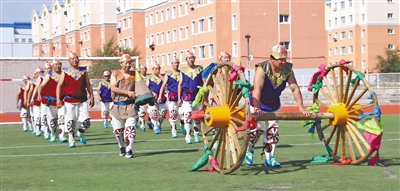
Teams enter the arena.
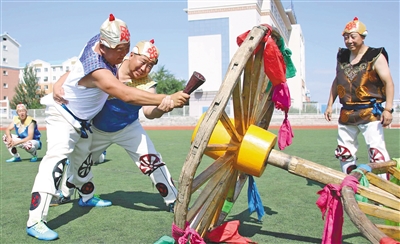
The gun pivoted for the score.
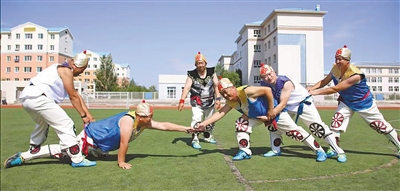
Center zone pivot.
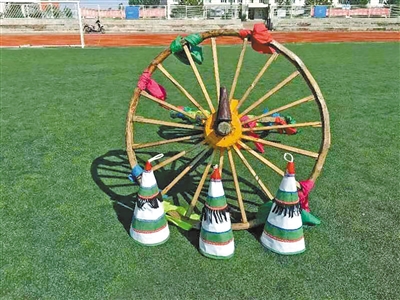
Gun pivot competition tool.
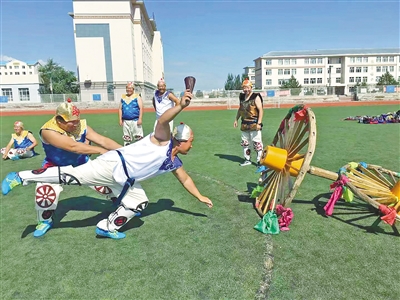
Hit the wheel in the wheel area to score.
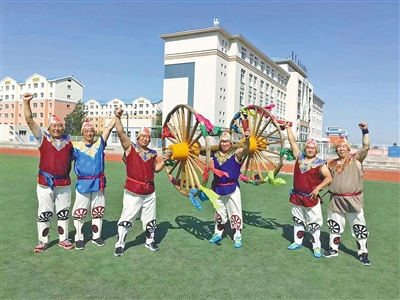
Win the gun pivot competition.

Hasenqige (third row, third from the left) walked into the campus to promote the gun pivot.
[Watching Traditional Skills and Listening to Fusion Stories (50)]
Ewenki grabbed the pivot, which is a folk sports activity created by Ewenki people in their long-term production and life. It is called Chinese football. With the continuous progress of society and the continuous improvement of people’s lives, this traditional national sports activity has become more and more familiar and has become a national intangible skill.
Origin folk has a long history.
Snatching pivot is mainly spread in Inner Mongolia. Pivot, which means pin in Ewenki, refers to the reinforced wooden clamping pin used by nomadic people to prevent the wheels from falling off. Grab the pivot is usually held at festivals such as Nadam, Aobaohui and Sabin Festival, together with wrestling, horse racing and archery.
Grab the pivot is also a sport that integrates entertainment and appreciation, especially suitable for nomadic life in mountainous areas and grasslands. One family or several families gather for entertainment and competition, and the elderly to teenagers can participate in different ways. It is loved by Ewenki, Mongolian, Daur, Oroqen and other ethnic minorities, and it is a national folk sport with a wide popularity.
Hasen Qige, a 75-year-old national intangible heritage inheritor of Ewenki’s pivot grab, said that the pivot grab originated from an ancient folklore: there was an old Ewenki named Zara, and many cars behind his family could not move because the pivot of the leading Lele car fell off during a migration. At this time, it was getting late, and the old man Zara said, "If anyone can find the pivot and repair the car, I will reward him well." So his two sons went to look for it separately. Soon after, Ji Gaha, a child, found the pivot and called out to everyone. After hearing the news, Giahi, the eldest son with infinite strength, fought with his younger brother in order to make a contribution, and finally grabbed the pivot and repaired the first car.
The old man said to his two sons, "Ji Gaha is not as strong as Ji Yaxi, but he is quick-sighted and can find a pivot under the dim starlight in the moonlight." Although Giahi is not as responsive as his younger brother, he has boundless strength and a tenacious sense of struggle, so both of them should be rewarded. " At the same time, the old man taught them, "You each have your own strengths. If you can unite and cooperate and learn from each other’s strengths, you will certainly overcome any difficulties in the future." Zara’s teachings were thought-provoking, and later generations of Ewenki people kept the pivot grabbing activity and became a competitive sport.
Preserve traditional integration and development
Snatching the pivot is both entertaining and combative. At that time, when the level of productivity was low, it embodied a national spirit of striving for progress.
The rules of the pivot grab competition have unique characteristics. Up to now, the competition has been divided into five to seven players from each side. Athletes from both sides relay to complete the pivot-seeking, pivot-passing, pivot-receiving and pivot-hitting in turn with reasonable technical actions and tactical cooperation in five areas, namely, the hidden pivot area, the forward attack area, the center area, the defender area and the wheel area, and complete the competition in five areas as a game, with the winner who scores more points. The method of grabbing the pivot is similar to that of football, but Mongolian wrestling is integrated into the confrontation, and the pivot can only be passed by hand, not thrown or kicked. This sport can exercise athletes’ patience and pivot grabbing skills, thus enhancing their sense of challenge, confrontation and flexible coping ability.
The competition of grabbing pivot can make athletes skillfully master various skills such as mutual utilization, mutual cooperation and mutual perfection, so as to achieve the best effect in actual combat.
The pivot competition is more traditional, with many original elements, and the venue design represents the stars and the moon in the sky; The middle trapezoidal main court represents the site where the pivot was searched and robbed during the original migration, and retains the color of the ancient legend. Competition can hone athletes’ endurance and speed. It is a traditional sport that integrates intelligence, competitiveness and appreciation. It has strong regional characteristics and retains the original state passed down from generation to generation.
Active rescue and continuous inheritance
In 1990s, with the Ewenki people gradually moving to cities and towns, the pivot grabbing movement gradually declined and faded out of the life of Ewenki people, so it is urgent to rescue and protect it. In order to protect and inherit this national traditional sports, the Ewenki Research Association was established in Ewenki Autonomous Banner of Hulunbeier City.
In 1997, 48-year-old Hasen Qiqige began to collect, dig and sort out relevant information about the pivot grabbing movement. In the process of protecting and sorting out the pivot grabbing project, she and her colleagues traveled all over Sumu and Gacha in Ewenki Autonomous Banner, and collected a lot of relevant information about the pivot grabbing project. The folklore of the origin of the pivot grab movement was collected by Hasen Qige.
She and her colleagues have sorted out the origin and rules of the game. On this basis, the local government has also held many training courses on the pivot-grabbing movement to spread the rich cultural connotation of the pivot-grabbing movement and innovate the form and content of the pivot-grabbing movement.
In 2000, grabbing the pivot was listed as a popular sports event in primary and secondary schools by the Education and Science and Technology Bureau of Ewenki Autonomous Banner, and Ewenki Middle School became a training base for grabbing the pivot. Up to now, the flag will hold a pivot-grabbing competition in large-scale activities such as the Sabin Festival and the Ice and Snow Festival held every year.
In 2007, Ewenki was included in the first batch of intangible cultural heritage list in Inner Mongolia with the promotion of the movement of grabbing pivot. In 2008, the Ewenki Qiangshu declared by Ewenki Autonomous Banner was included in the second batch of national intangible cultural heritage list. In 2009, Hasenqige became the representative inheritor of Ewenki, a national intangible cultural heritage.
For thousands of years, Le Le Che has carried Ewenki people, crossing long life scars in the vast grassland with a cool breeze. After a long period of development, it has been endowed with new connotations and has become a national sports with certain ideological, educational, entertaining and ornamental features. In 2023, as a traditional sports event, grabbing the pivot became the event of the 10th traditional minority sports meeting in Inner Mongolia Autonomous Region.
Text/Grassland Full Media Zhengbei Net reporter Gao Ruifeng
(Photo by Ao Tielin)
Let the national culture glow with splendor.
□ Su Yongsheng
As a traditional sports event of Ewenki nationality, it is loved by the masses because of its strong competitiveness, high interest and wide participation of the masses. It has become an indispensable competition event for traditional festivals and major events of this nationality, and has been selected into the national intangible cultural heritage list, becoming one of the projects of traditional sports meetings of ethnic minorities in the whole region.
The excellent culture of ethnic minorities is a beautiful flower in the colorful garden of Chinese culture; Traditional sports of ethnic minorities are a beautiful scenery in China’s national sports. Inheriting and carrying forward excellent minority culture and traditional minority sports is of great significance for inheriting and carrying forward Chinese excellent traditional culture, enriching the content and form of national traditional sports, enhancing national unity and promoting exchanges and integration among all ethnic groups.
A traditional sports has its historical roots and profound cultural connotations. To protect, inherit and carry forward the traditional sports of ethnic minorities, we should not only protect the sports itself, but also protect the profound culture behind it, tap its internal factors conducive to national unity, and make contributions to building the sense of community of the Chinese nation.
Many people have made painstaking efforts to inherit and carry forward the national culture. In particular, many inheritors of intangible cultural heritage, through their long-term persistence, excavated and sorted out information about cultural heritage, compiled books to protect and inherit cultural heritage, and contributed to the inheritance and promotion of cultural heritage.
At the national and social levels, many excellent traditional cultures have been listed in the intangible cultural heritage protection list by relevant departments. Many traditional sports events of ethnic minorities have been included in the competitions or performances of traditional sports meetings of ethnic minorities at different levels. The colorful traditional sports competitions of ethnic minorities held in various places not only satisfy the appreciation of the people, but also build a good platform and create positive conditions for further research on the excellent traditional culture of ethnic minorities.
Colorful excellent cultures of all ethnic groups bear the good wishes of the people of all ethnic groups and reflect their yearning and pursuit of a better life. It is the responsibility entrusted to us by the times to inherit and carry forward the excellent cultures of all ethnic groups, enhance cultural identity, strengthen cultural self-confidence and build a spiritual home shared by all ethnic groups.
The Chinese nation is a family, working together to build the Chinese dream. Inheriting and carrying forward China’s excellent traditional culture and building a strong cultural country require arduous efforts from all walks of life. Only when all of us, Qi Xin, join hands and work together to protect, inherit and carry forward the great practice of Chinese excellent traditional culture can our cultural garden be more colorful and our national culture more splendid.